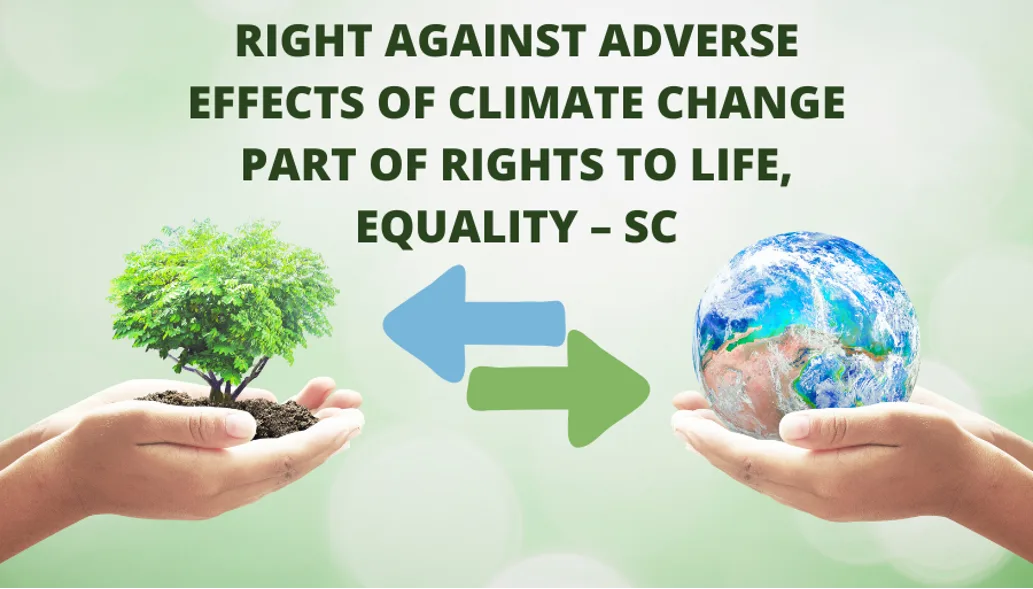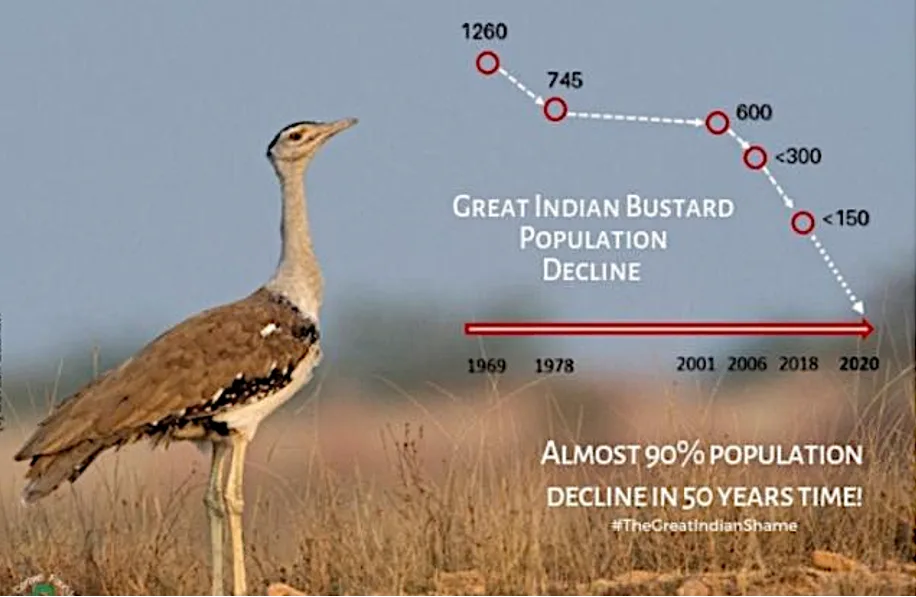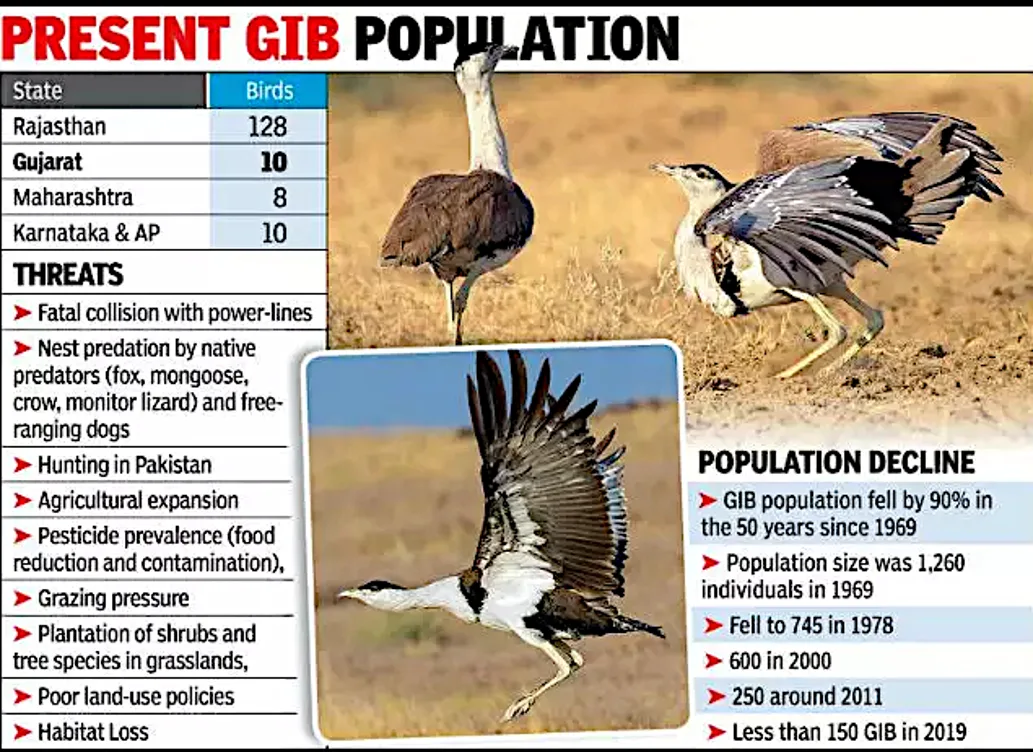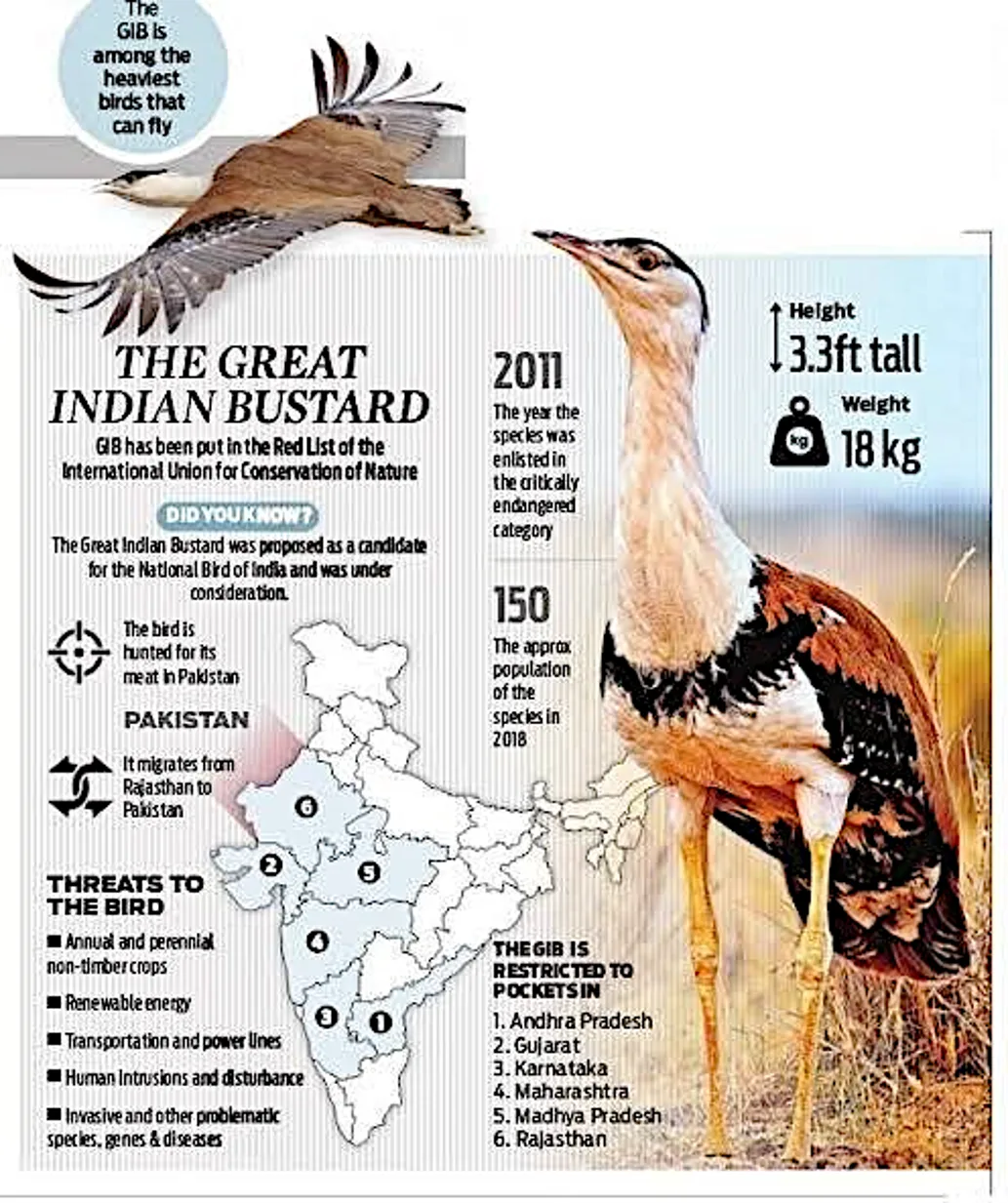What’s in this Article?
- Table of Contents
- Why in the News?
- Constitutional Provisions Related to Environment
- Background of M K Ranjitsinh & Ors. vs Union of India Case:
- The Great Indian Bustard (GIB)
- Other SC rulings on Environmental Issues
- Supreme Court’s verdict regarding the protection against Climate Change
- The necessity for the Right to be Free from the Adverse Impacts of Climate Change
- How have the Courts interpreted Article 21 in the past?
- Earlier Interpretation and Expansion of the Scope of Article 21
- Way Forward
- Conclusion
- FAQs
- MCQs
Why in the News?
- The Supreme Court of India on April 5, 2024, for the first time, recognised the right against the adverse impacts of climate change, saying it is intertwined with the right to life and equality that are embedded in the Indian constitution.
- The Court of asserted that this right is closely linked with the right to life (Article 21) and the right to equality (Article 14) as outlined in the Indian Constitution.
- The arguments were a part of a verdict by a three-judge bench headed by the Chief Justice of India DY Chandrachud hearing a case on the conservation of the Great India Bustard (GIB) and the lesser florican.
- It underscores the importance for nations such as India to fulfill their global responsibilities toward promoting well-being and fostering sustainable growth [M K Ranjitsinh & Ors. vs Union of India].
Constitutional Provisions Related to Environment
- Article 48A of the Constitution provides that the State shall endeavor to protect and improve the environment and to safeguard the forests and wildlife of the country.
- Clause (g) of Article 51A stipulates that it shall be the duty of every citizen of India to protect and improve the natural environment including forests, lakes, rivers and wildlife, and to have compassion for living creatures.
Background of M K Ranjitsinh & Ors. vs Union of India Case:
- The matter concerned the preservation of the highly endangered Great Indian Bustard (GIB).
- In 2021, a legal petition was submitted by M K Ranjitsinh, a former government official and conservation advocate, aiming to safeguard the GIB and the Lesser Florican, both facing imminent extinction.
- A ruling issued by the Supreme Court on April 19, 2021, imposed restrictions on the installation of overhead transmission lines within approximately 99,000 square kilometers of GIB habitat in Rajasthan and Gujarat.
The Great Indian Bustard (GIB)
- The Great Indian Bustard (Ardeotis nigriceps), designated as the State bird of Rajasthan, holds the unfortunate title of being India’s most severely endangered avian species.
- Serving as a symbolic icon of grassland vitality, its distribution is primarily limited to Rajasthan and Gujarat, with smaller populations found in Maharashtra, Karnataka, and Andhra Pradesh.
- However, its survival is perpetually imperiled by various factors including collisions/electrocutions with power lines, ongoing hunting (particularly prevalent in Pakistan), habitat degradation due to extensive agricultural development, among other threats.
- Protection Status:
- IUCN red List: Critically Endangered
- Convention on International Trade in Endangered Species of Wild Fauna and Flora (CITES): Appendix1
- Convention on Migratory Species (CMS): Appendix I
- Wildlife (Protection) Act, 1972: Schedule I
Who applied for modification of an earlier case?
- The Ministries of Power, Environment, Forest and Climate Change, and New and Renewable Energy sought to amend the 2021 order, citing adverse effects on India’s power sector and the impracticality of undergrounding power lines.
- They highlighted the Paris Climate Treaty (2015) as a significant reason for seeking this modification.
Other SC rulings on Environmental Issues
- The Supreme Court on several occasions in the past few decades has relied on the Constitution to uphold human rights pertaining to environmental issues.
- MC Mehta vs Kamal Nath 2000: SC held that any disturbance of the basic environment elements, namely air, water and soil, which are necessary for ‘life’, would be hazardous to ‘life’ within the meaning of Article 21 of the Constitution.
- SC held that Right to life within Art 21 includes the right to live in a healthy environment, right to enjoy pollution-free water and air, and right to live in a pollution-free environment.
- Virender Gaur vs State of Haryana1995: It is the imperative duty of the State governments and municipalities to take adequate measures to promote, protect and improve both the man-made and the natural environment.
- Karnataka Industrial Areas Development Board vs C Kenchappa, 2006: Supreme Court took note of the adverse effects of rising sea levels and rising global temperatures.
- Bombay Dyeing & Mfg. Co. Ltd. (3) Bombay Environmental Action Group, 2006: Supreme Court recognised that climate change posed a “major threat” to the environment.
Supreme Court’s verdict regarding the protection against Climate Change
The Supreme Court’s decision pertains to a case involving the preservation of the endangered Great Indian Bustard Species.
- Fundamental Right to Environmental Health – The ruling establishes that the right to a healthy environment, free from the detrimental impacts of climate change, is a fundamental entitlement.
- Broadened Interpretation of Fundamental Rights – The Court has interpreted Articles 14 and 21 expansively, stating that the right to life (Article 21) and the right to equality (Article 14) cannot be fully realized without a clean and stable environment. It expands the purview of these articles to emphasize the necessity of safeguarding lives and livelihoods amidst climate change.
- Impact on Right to Health – Climate change adversely affects the right to health, which is integral to the right to life (Article 21). Factors like air pollution, vector-borne diseases, rising temperatures, and droughts exacerbate this impact.
- Impact on Right to Equality – Climate change and environmental degradation disproportionately affect poorer communities, leading to food and water shortages. Marginalized groups such as forest dwellers, tribal, and indigenous communities face a higher risk of losing their homes and cultural heritage.
- Interconnection between Climate Change and Human Rights – The Supreme Court acknowledges that climate change affects various human rights, including the right to health, indigenous rights, gender equality, and the right to development.
- Relationship between Right against Climate Change and Right to Clean Environment – The Court observes that the right to protection against the adverse effects of climate change and the right to a clean environment are interconnected. However, given the escalating adverse impacts of climate change, recognizing the right against these effects as a distinct entitlement becomes imperative.
The necessity for the Right to be Free from the Adverse Impacts of Climate Change:
- Increasing Vulnerabilities: The evidence of Indians’ vulnerability to climate change is escalating. Floods are occurring more frequently and with greater intensity. Shifts in rainfall patterns are noticeable, and heatwaves are presenting significant health hazards. Various studies, including reports from the IPCC, have cautioned that global warming will increasingly endanger Indians in the years ahead.
- Significant Impact on Communities & Cultures: Indigenous communities such as tribes in the Andaman and Nicobar Islands rely heavily on nature, with their connection to it often intertwined with their culture or religion. The destruction of lands and forests or their forced relocation could lead to a permanent loss of their distinct cultural identity. Thus, climate change may also affect the constitutional guarantee of the right to equality (Article 14).
- Risk of Exacerbating Inequality: If climate change and environmental degradation cause severe shortages of food and water in certain areas, marginalized communities will bear a disproportionate burden compared to wealthier ones. The inability of underserved communities to adapt to or cope with climate change violates both the right to life (Article 21) and the right to equality (Article 14).
- Lack of Priority: Despite the escalating toll of receding glaciers, landslides, rising sea levels, air pollution, and the loss of green spaces, these issues rarely gain attention from the country’s political leaders, even during election periods. Environmental concerns have largely remained the domain of academics, civil society groups, and activists.
- Inadequate Executive Action: Governments have often disregarded Supreme Court rulings highlighting the interconnectedness of ecology and human dignity. The ongoing air pollution crisis in Delhi exemplifies the gap between legal precedents and policy implementation.
- A Question & Hindrance to Development: Environmental issues like air and water quality only garner attention when they reach crisis levels. However, with the looming threat of climate change, this approach becomes unsustainable. Such events raise doubts about the country’s development strategies, which have not always been sensitive to ecological considerations.
- Lack of Legal Framework: India’s legal framework lacks a comprehensive climate change law. Despite various regulations and policies aimed at addressing the adverse effects of climate change, there is no singular legislation dedicated to this issue. Nevertheless, the absence of such legislation does not negate Indians’ entitlement to protection against the adverse impacts of climate change.
How have the Courts interpreted Article 21 in the past?
- Article 21, regarded as the cornerstone of Fundamental Rights, has been construed by the Supreme Court (SC) as pivotal. The SC underscores that Article 21, which guarantees the right to life, extends beyond mere survival to encompass all essential elements required for a meaningful and respectable existence.
- Expansion of Environmental Rights under Article 21: During the 1980s, the SC broadened the scope of Article 21 to integrate the right to a healthy environment, along with a spectrum of other entitlements such as education, housing, unpolluted air, sustenance, and healthcare.
- Implementing Novel Entitlements: Despite the acknowledgment of these additional entitlements, citizens frequently encounter hurdles in actualizing them, especially in instances pertaining to environmental concerns like ensuring clean air.
Earlier Interpretation and Expansion of the Scope of Article 21
- Heart of the Rights: The Supreme Court has said that the right to life is not just mere existence, but that it includes all rights that make it a meaningful and dignified existence for an individual.
- In the 1980s, the SC read the right to a clean environment as part of Article
- Virender Gaur v. State of Haryana (1994): Recognition that the right to a clean environment is an integral facet of the right to a healthy life.
- Right to Speedy Trial: In Hussainara Khatoon Vs. the State of Bihar (1979), the Supreme Court declared that the right to speedy trial is an essential component of fairness in criminal justice.
- Right to Health: In the case of Parmanand Katara Vs. Union of India (1989), the Supreme Court held that every doctor has a professional obligation to protect human life in emergencies.
- Right to Livelihood: In the Olga Tellis Vs. Bombay Municipal Corporation (1985) case
- Protection against Illegal Detention: In DK Basu Vs. State of West Bengal (1997) case
- Right to Shelter: In Chameli Singh Vs. State of UP (1996) case
- Right against Sexual Harassment at Workplace: In Vishaka Vs. State of Rajasthan (1997) case
- Right to Clean Environment: In Subhash Kumar Vs. State of Bihar and Ors (1991)
- Right to Privacy: In KS Puttaswamy Vs. Union of India (2017) judgment
- Right to Education: In Mohini Jain Vs. State of Karnataka (1992) case
- Right to Good Roads: In the Road Accident case of 2004, the Supreme Court ruled that good roads free from potholes and safe for pedestrians and vehicles are a part of the right to life under Article
- Right to Sleep: In the case of Amir Khan vs. State of Gujarat in 2012
- Right to Die With Dignity: In Aruna Ramachandra Shanbaug vs. Union of India 2011 case
- Right against Torture and Inhuman Treatment: In the DK Basu case (1996)
Way Forward:
- Implementing laws to uphold the right: Implementing legislation and crafting policies aimed at combating climate change are crucial steps in ensuring that citizens’ rights against climate change are truly upheld.
- Integration into Political Manifestos: It is imperative that the acknowledged fundamental right to combat climate change finds its place within the political manifestos of parties contesting in the Lok Sabha Elections. These manifestos should detail their strategies for realizing these rights.
- Bridging the gap between environmental law and policy: Governments should give due regard to Supreme Court rulings emphasizing the interconnectedness of ecology and human dignity. Efforts should be made to prevent discrepancies between environmental law and policy, as seen in instances such as the Delhi Air Pollution case.
Conclusion:
- The acknowledgment by the Supreme Court of individuals’ entitlement to protection from the negative impacts of climate change broadens constitutional safeguards, bolsters environmental fairness, shapes discussions on policy, and establishes a pivotal legal precedent.
- The Judgement regarding the entitlement to be protected from the negative impacts of climate change under constitutional fundamental rights sets the stage for holding accountable any actions that hinder the achievement of climate goals.
- This landmark case greatly impacts the legal principles governing climate management in India.
Disclaimer: The article may contain information pertaining to prior academic years; for further information, visit the exam’s “official or concerned website“.
Frequently Asked Questions (FAQ’s)
Q. What is Great Indian Bustard (GIB)?
- The Great Indian Bustard (GIB) is a large bird that lives in dry grasslands and scrublands on the Indian subcontinent. It is one of the world’s heaviest flying birds and is the state bird of Rajasthan.
Q. What is Article 21 of the Constitution of India?
- Article 21 of the Constitution of India protects the right to life and personal liberty. It states that no person can be deprived of these rights except according to a procedure established by law. This fundamental right is available to all people, both citizens and non-citizens.
MCQ’s
Q. What constitutional right in India is relevant to citizens’ climate rights?
- Right to Education
- Right to Clean Water
- Right to Life
- Right to Own Property
Ans: c) Right to Life
Q. How does the recognition of climate rights impact legal accountability in India?
- It reduces legal accountability for environmental damages.
- It increases legal accountability for actions contributing to climate change.
- It has no effect on legal accountability.
- It limits citizens’ ability to seek legal recourse.
Ans: b) It increases legal accountability for actions contributing to climate change.
Q. Which branch of the Indian government plays a significant role in upholding citizens’ climate rights?
- Legislative
- Executive
- Judiciary
- Military
Ans: c) Judiciary
Q. What does the recognition of climate rights imply for the Indian government?
- It implies no obligation to address climate change.
- It implies a commitment to prioritize climate action.
- It implies complete control over natural resources.
- It implies a relaxation of environmental regulations.
Ans: b) It implies a commitment to prioritize climate action.
Q. Which of the following is NOT a potential impact of recognizing climate rights in India?
- Empowering citizens to hold the government accountable for addressing climate change.
- Strengthening legal frameworks related to environmental protection.
- Reducing the significance of environmental concerns in policymaking.
- Fostering a culture of environmental responsibility among citizens.
Ans: c) Reducing the significance of environmental concerns in policymaking.
Explore our courses: https://apnipathshala.com/courses/
Explore Our test Series: https://tests.apnipathshala.com/














1 thought on “The Citizen’s ‘climate rights’”
Give related pics in every article/editorials
Comments are closed.